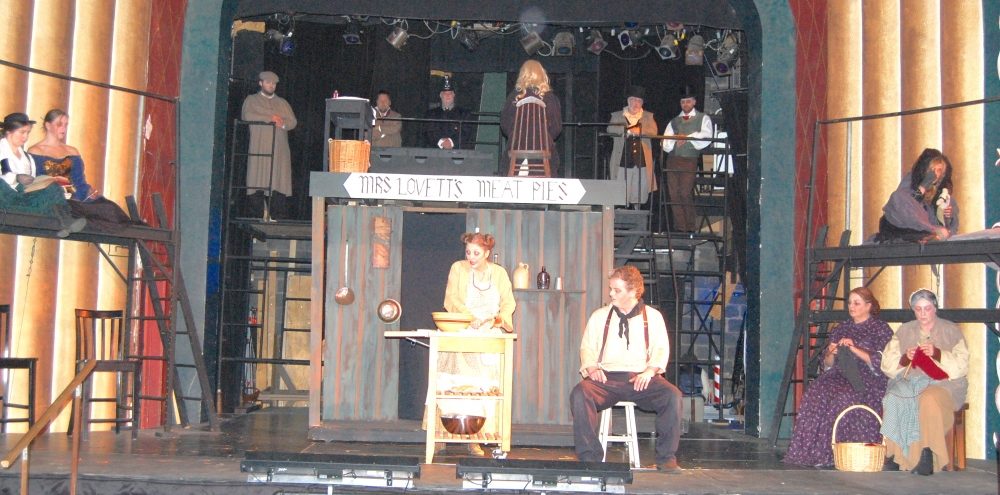
Anyone who enjoys the theater should make it a point to see Sweeney Todd – The Demon Barber of Fleet Street, by Stephen Sondheim and Hugh Wheeler, currently playing at the Garfield Center for the Arts.
Directed by Shelagh Grasso, with musical direction by Julie Lawrence, Sweeney Todd is an intense, sometimes overwhelming, story of murder, cannibalism, injustice – and love. With a touch of humor. That’s a tall order and the Garfield production comes through.
Originally a 1973 play by Christopher Bond, Sweeney Todd takes its material from the Victorian “penny dreadfuls”– one of which introduced the murderous barber Todd in a serialized thriller, “The String of Pearls” in the late 1840s. It was so popular that it was turned into a play even before its final installment, and numerous spin-offs followed. Bond added a level of psychological sophistication to the Victorian original, and the London production of the play inspired Sondheim to adapt it as a musical in 1979.
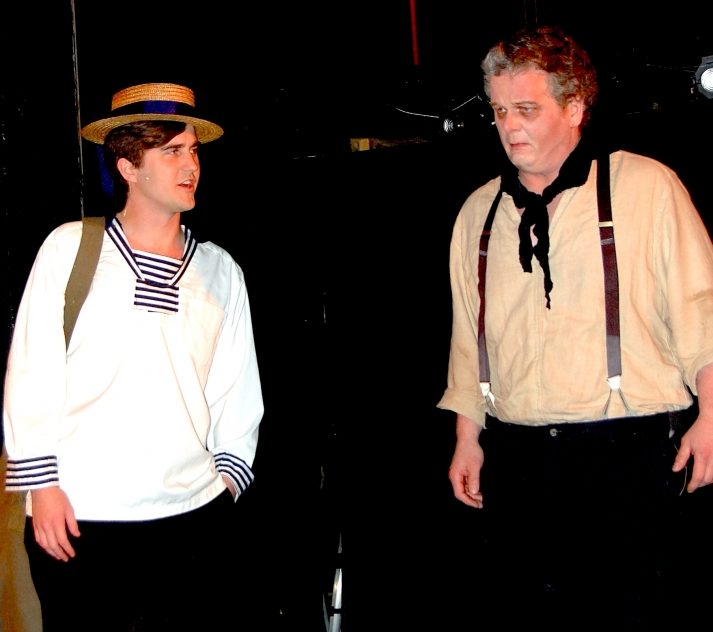
The sailor Anthony rescued and befriended barber Sweeney Todd. Photo by Carmen Grasso
The original Broadway production featured Len Cariou in the title role and Angela Lansbury as Mrs. Lovett, his partner in crime, with Hal Prince directing. It ran for 557 performances before going on a national tour. It won an astounding eight Tony Awards, and followed up with nine Drama Desk awards – including best musical, best male and female actors, best director, and best score. Not surprisingly, it has been revived numerous times, with a 2007 film adaptation starring Johnny Depp.
The plot revolves around a London barber banished to the penal colonies of Australia on trumped-up charges by a crooked judge who had designs on the barber’s wife. Now fifteen years later, the barber has returned to England, accompanied by a young sailor, Anthony Hope, who rescued him at sea. After telling Anthony a version of his tale, Todd goes to a meat pie shop on Fleet Street, where the proprietress, Mrs. Lovett complains about how hard it is to find meat. He asks her about her upstairs apartment, which he reveals that he himself used to rent under his former name before he was arrested. She tells him, in turn, that his wife committed suicide and that the crooked judge adopted his then-infant daughter Johanna.
Mrs. Lovett agrees to rent him the apartment and promises to keep his secret. She also gives him back his old set of razors which she has kept all these years, so he can go back into business as a barber again. But Todd has sworn revenge on the judge, and that decision shapes everything else that happens.
Meanwhile, Anthony has seen a beautiful young woman singing out of her window, and falls instantly in love with her. Her name, he learns, is Johanna – then the judge and his beadle chase him away, threatening bodily harm if he returns. Unwittingly, he has fallen in love with Todd’s daughter.
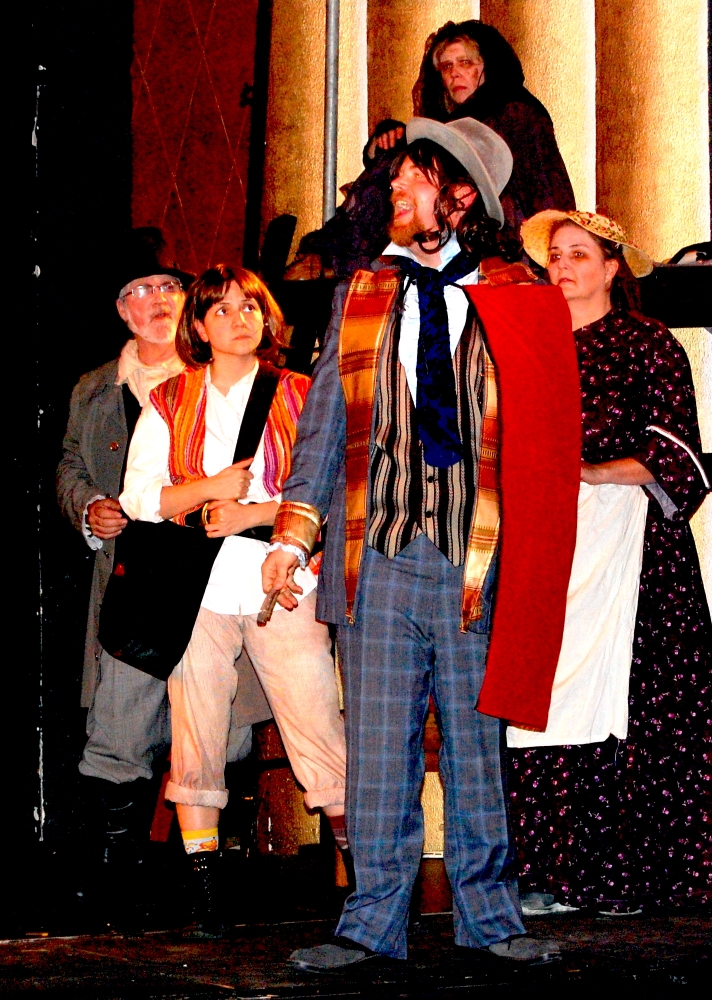 Back on Fleet Street. Todd wins a shaving contest against an Italian barber, Pirelli, allowing him to call himself the best barber in London. The judge’s beadle, impressed, makes an appointment to come back for a shave – which Todd sees as a chance for revenge on one of the men who framed him. When Anthony then appears and tells of his love for Johanna, Todd promises Anthony he can use his shop as a meeting place for their elopement.
Back on Fleet Street. Todd wins a shaving contest against an Italian barber, Pirelli, allowing him to call himself the best barber in London. The judge’s beadle, impressed, makes an appointment to come back for a shave – which Todd sees as a chance for revenge on one of the men who framed him. When Anthony then appears and tells of his love for Johanna, Todd promises Anthony he can use his shop as a meeting place for their elopement.
But before that can happen, Pirelli and his assistant Tobias appear and Pirelli asks for a shave. Mrs. Lovett takes Tobias downstairs for a meat pie, and Pirelli reveals that he knows who Todd is and tries to blackmail him. So Todd slits his throat and Mrs. Lovett makes Tobias an assistant, pretending that Pirelli has been called away on business. And she sees the need to dispose of the body as an opportunity – after all, she still needs meat for her pie business!
From there, the plot moves inevitably toward its conclusion – a dark and bloody apocalypse in the great tradition of the “penny dreadful.” Needless to say, this is not a play for young children – perhaps not for anyone disturbed by the sight of stage blood, or who thought Jonathan Swift’s “A Modest Proposal” was too gross. However, it’s important to note that while the plot has numerous on-stage murders, there is really not a lot of blatant on-stage gore. But there’s no excuse for anyone else to miss this production – one of the most powerful in the local theater in recent years.
Grasso has assembled a top-notch cast, with many who are making their first local appearance.
Christopher Wallace, who directed CHT’s recent production of Witness for the Prosecution, plays the title role. He does a nice job walking the fine line between Todd as a victim of injustice and as a monster – both aspects of which come to the fore at different times. A memorable performance in a difficult role.
Jane Copple, who has a long string of credits in Church Hill Theatre musicals, is a good fit for the role of Mrs. Lovett. Her voice is one of the best in the cast, and she conveys the comic aspects of the character well.
Max Hagan, who has a theater degree from Sewanee, gets to show off a nice voice as Anthony Hope. One of the most sympathetic characters in this generally dark play, he could be seen as the moral center of the play.
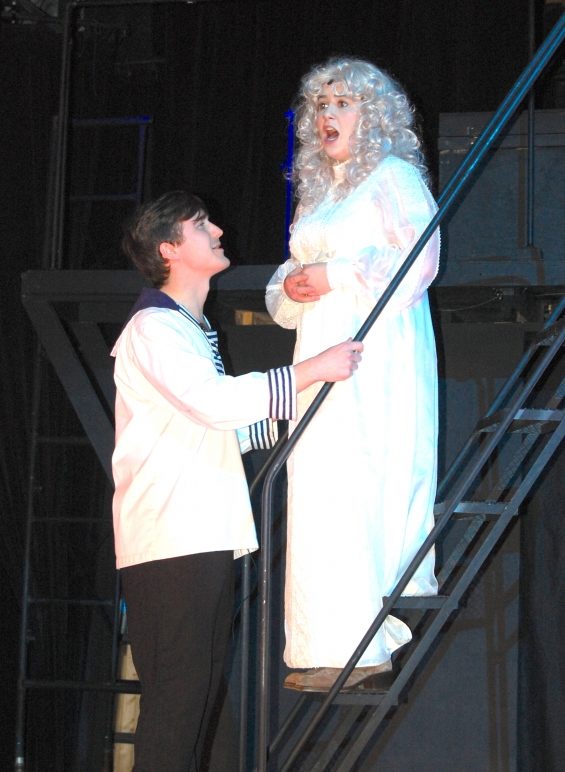
Thwarted lovers Anthony and Johanna in “Sweeney Todd” at Garfield Theatre Photo by Carmen Grasso
Natalie Lane, who previously appeared in the Garfield production of My Fair Lady, plays Tobias, the young boy who becomes an apprentice to Mrs. Lovett in the pie shop. Her voice is excellent and she is convincing as a London street urchin.
Matt Folker is cast as Judge Terpin, the main villain of the piece, and Nic Carter plays Beadle Bamford, his unsavory henchman. Both do fine jobs of embodying the entrenched evil that ends up creating a serial murderer, the “demon barber of Fleet Street.”
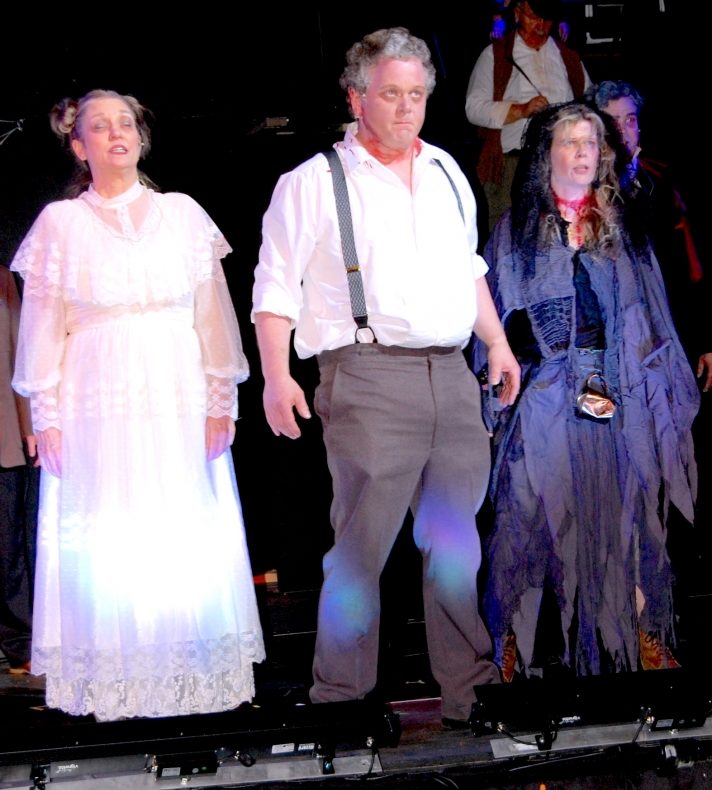
Jane Copple as Mrs. Lovett, Christopher Wallace as Sweeney Todd, and Melissa McGlynn as the Beggar Woman/Lucy in “Sweeney Todd”, a 2018 production at Garfield Theatre. Photo by Carmen Grasso
Melissa McGlynn plays a beggar woman who turns out to have a more significant role in the plot than first appears. A solid performance from one of our local theatrical stars.
Shannon Whitaker is well cast as Johanna, Sweeney’s daughter. She displays a beautiful singing voice in her featured number, “Green Finch and Linnet Bird.”
Zack Schagg, Howard Messick, Zac Ryan and Kendall Davis round out the list of characters with speaking parts, and all do good jobs. Likewise the chorus – which includes a large number of familiar on-stage faces – is an impressive presence, acting, as Grasso said after the opening night performance, almost as a Greek chorus, telling the story in operatic style. There is a wonderful “madhouse” scene in which Anthony goes to rescue Johanna from the lunatic asylum. The lunatics–in particular, Marcia Gilliam–are delightfully mad. And then there is the “more pie” scene where the local townspeople wipe their lips and swing their mugs of ale while calling for “more pie”. All in song!
The set, designed and built by Carmen Grasso, is astonishing in its own right. The main piece, sitting at center stage, swivels around to show two different fronts – one Mrs. Lovett’s pie shop, the other a generic street scene. On a second level, it shows Todd’s barbershop – including a chute down which he drops the victims of his butchery so the “meat” can be used for pies. A very clever and useful feature! And this is just the centerpiece – there are levels upon levels all around it, with chorus members lurking to observe and add their voices where the score calls for it. There’s even scaffolding out in the audience, behind the orchestra pit. Be sure to look all around you as the play goes on – there’s a lot happening!
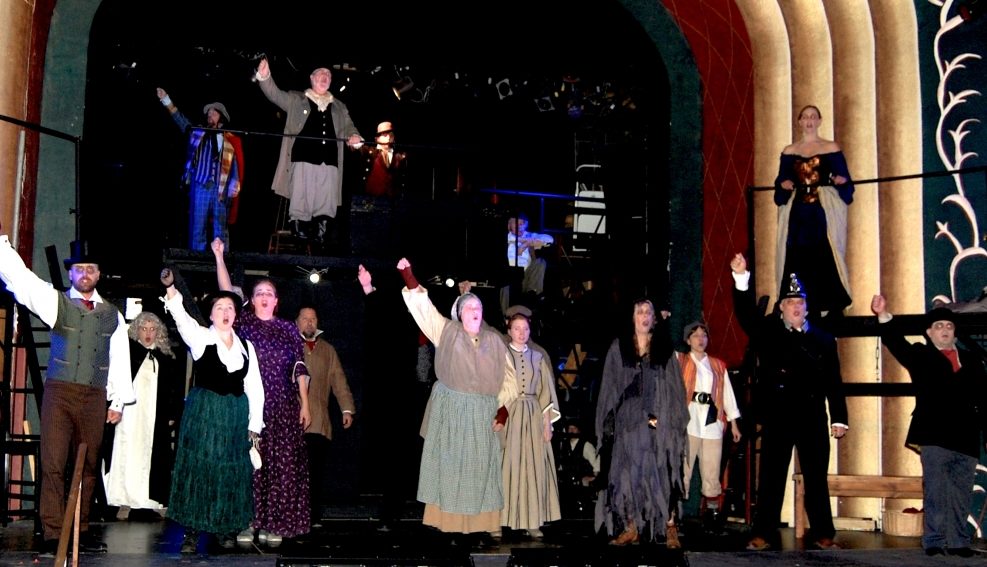
“Sweeney Todd” performance at Garfield Theatre Photo by Carmen Grasso
The costuming convincingly recreates the look of 1840s London working and middle class. In the early scenes, both Lovett and Todd’s clothes are worn and not of the highest fashion. But as the “pie” shop prospers, both characters sport a posher look, with Todd in a good-quality suit and Mrs. Lovett wearing a fashionable dress with a beautiful–and obviously expensive–embroidered shawl. Johanna, the barber’s daughter, looked lovely in a white gown and long flowing tresses. A great wig! Good job by costume designer Barbi Bedell and her crew.
In fact, despite the complexity of the choreography and blocking and the large number of characters onstage at any given time, the play feels very tight. Grasso has done an impressive job bringing everything together into a unified whole. This only adds to her already high ranking among directors in the local theater community. A special mention should also go to choreographer and assistant director Greg Minahan. Minahan comes to the Garfield with an impressive list of credits that include singing, dancing and choreography on Broadway in such productions as CATS and Peter Pan. Locally, Minihan has acted and directed for both Shore Shakespeare and Church Hill Theatre.
A couple of quibbles. The dialogue was sometimes hard to understand – especially with characters singing in Cockney accents. Occasionally, lyrics were covered up by the orchestra – especially in some chorus pieces. This may improve as the cast settles in. And the lighting seemed dimmer in spots than it might have been. There were also a few opening-night glitches such as when actors moved out of their spotlights. But nothing that really detracted from the enjoyment of the production.
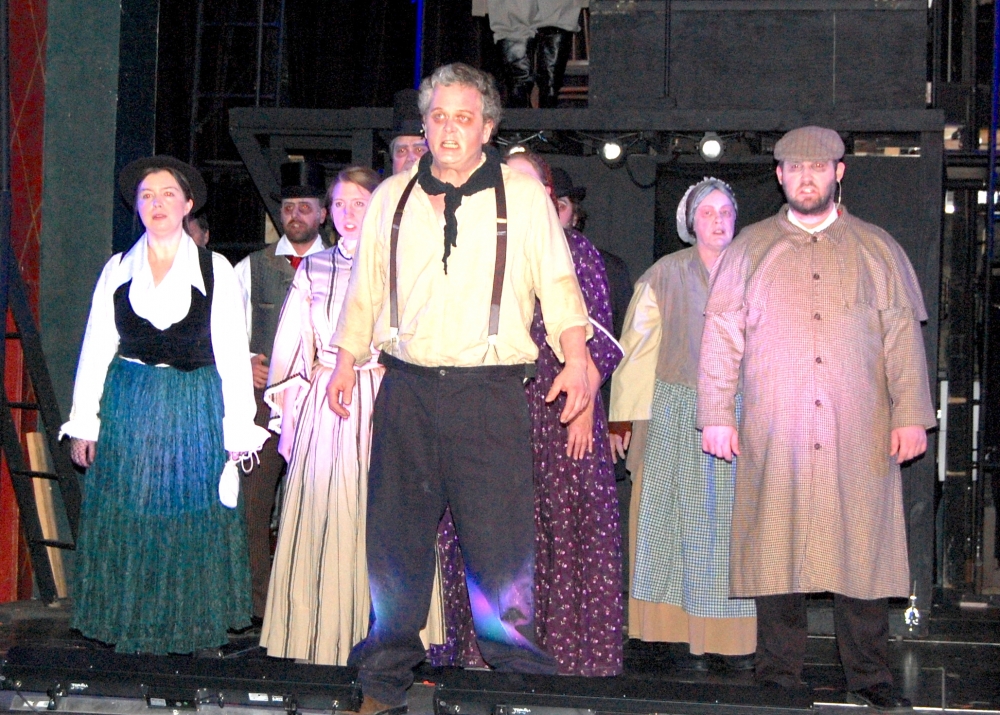
“Sweeney Todd” performance at Garfield Theatre Photo by Carmen Grasso
Sondheim’s music is complex and challenging. Some songs are gentle and sweet, expressing themes of love and loyalty, such as the duet “Not While I’m Around” between Mrs. Lovett and Tobias. But Sondheim also uses dissonance–sometimes high-volume dissonance–to convey the more shocking emotional elements of the story. This is, after all, a story of murder and mayhem! And the music reflects that. Those who are more attuned to the musicals of Rodgers and Hammerstein or Lerner and Loewe may want to adjust their expectations accordingly. I myself lean more toward Gershwin and Porter but found the music in Sweeny Todd to be both powerful and dramatically effective.
There’s plenty of energy, and the orchestra seemed to be very tight. The quality of the singers’ voices is universally high. There were a couple of points where two singers in a duet appeared to be in different keys – but without having the score right there, it was hard to tell if this was intentional or not. Again it was not enough to detract from the overall excellence of the music. Of course, given the theme of the show, it is consistent for the music–though quite lyrical at times–to also be uncomfortable at other points. Kudos to Julie Lawrence who brought it all together.
Sweeney Todd, as noted above, is an intense, gripping theatrical experience, and Grasso’s production pulls no punches. Note that it is a long show, running just under three hours. The local theater community deserves high marks for bringing this show to the Garfield and bringing to it such an effective performance. Go see it.
Sweeney Todd runs at the Garfield through May 13, with performances at 8 p.m. Friday and Saturday and at 3 p.m. Sundays. For reservations, call 410-810-2960 or visit [email protected].
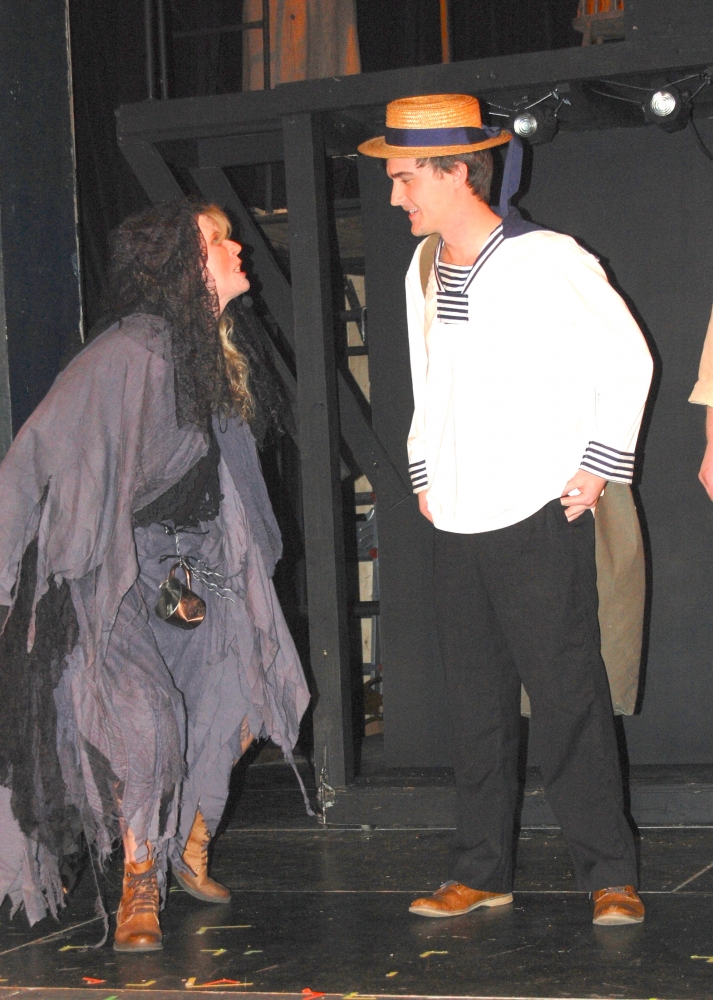
The local beggar and mad woman confronts Anthony. Sweeney Todd at the Garfield Theatre. Photo by Carmen Grasso
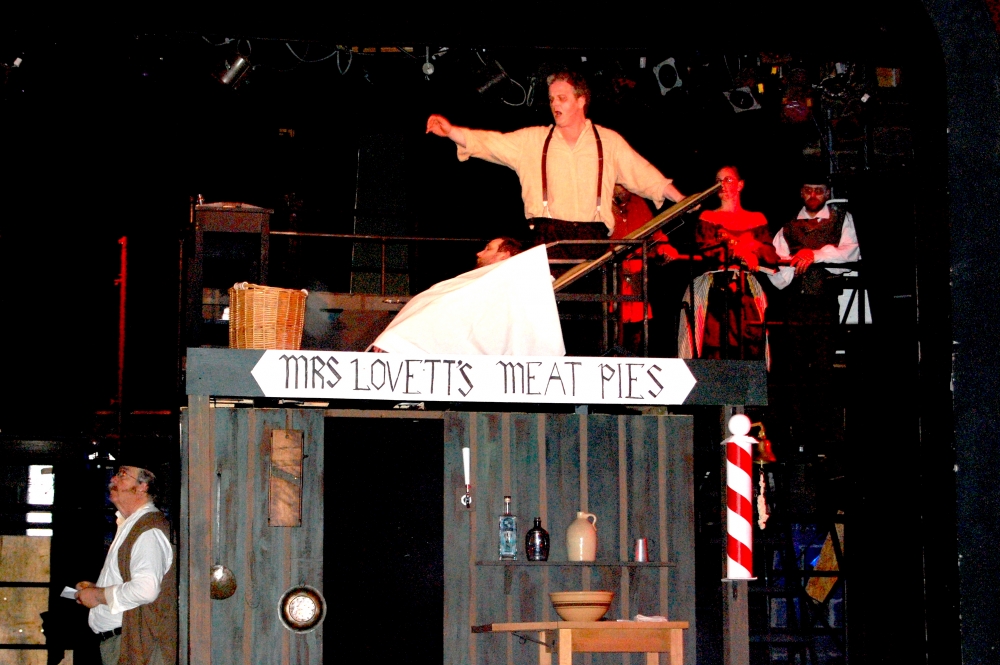
Another victim of the Demon Barber meets his fate in “Sweeney Todd” at Garfield Theatre. Photo by Carmen Grasso

Mrs. Lovett and her assistant Tobias in “Sweeney Todd” at Garfield Theatre. Photo by Carmen Grasso
###
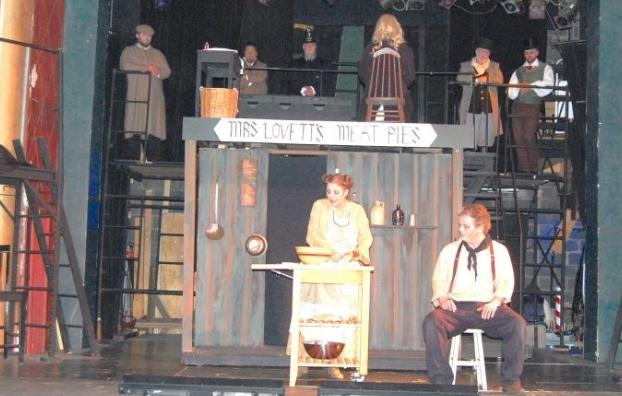


Write a Letter to the Editor on this Article
We encourage readers to offer their point of view on this article by submitting the following form. Editing is sometimes necessary and is done at the discretion of the editorial staff.